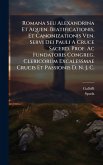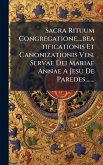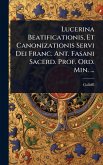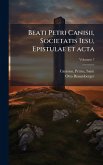This historical document, written in Dutch, pertains to the beatification and canonization process of the Venerable Servant of God, Peter Canisius, a professed priest of the Society of Jesus. The title, "Sacra Rituum Congregatione E[mminentissi]mo, & R[everendissi]mo D[omi]no Card. De Gentilibus Lavsannen. Beatificationis, & Canonizationis Ven. Servi Dei Petri Canisii Sacerdotis Professi Societatis Iesu Positio Super Dubio An, & Quomodo Sit Signandu...", indicates its formal nature within the Sacred Congregation of Rites. It likely contains arguments and evidence presented to Cardinal de Gentilibus concerning the signs and miracles associated with Peter Canisius, a crucial step in the path to sainthood. This book offers valuable insights into the intricate procedures of the Catholic Church regarding the recognition of saints and the historical context of Peter Canisius's life and works. It will be of interest to scholars of religious history, particularly those focusing on the Jesuit order and the process of canonization. This work has been selected by scholars as being culturally important, and is part of the knowledge base of civilization as we know it. This work was reproduced from the original artifact, and remains as true to the original work as possible. Therefore, you will see the original copyright references, library stamps (as most of these works have been housed in our most important libraries around the world), and other notations in the work. This work is in the public domain in the United States of America, and possibly other nations. Within the United States, you may freely copy and distribute this work, as no entity (individual or corporate) has a copyright on the body of the work. As a reproduction of a historical artifact, this work may contain missing or blurred pages, poor pictures, errant marks, etc. Scholars believe, and we concur, that this work is important enough to be preserved, reproduced, and made generally available to the public. We appreciate your support of the preservation process, and thank you for being an important part of keeping this knowledge alive and relevant.
Bitte wählen Sie Ihr Anliegen aus.
Rechnungen
Retourenschein anfordern
Bestellstatus
Storno

![Sacra Rituum Congregatione E[mminentissi]mo, & R[everendissi]mo D[omi]no Card. De Gentilibus Lavsannen. Beatificationis, & Canonizationis Ven. Servi Dei Petri Canisii Sacerdotis Professi Societatis Iesu Positio Super Dubio An, & Quomodo Sit Signandu... - Canisius, Petrus Sacra Rituum Congregatione E[mminentissi]mo, & R[everendissi]mo D[omi]no Card. De Gentilibus Lavsannen. Beatificationis, & Canonizationis Ven. Servi Dei Petri Canisii Sacerdotis Professi Societatis Iesu Positio Super Dubio An, & Quomodo Sit Signandu... - Canisius, Petrus](https://bilder.buecher.de/produkte/74/74677/74677450n.jpg)
![Polona, Seu Luceoriensis Beatificationis, Et Canonizationis Ven. Servi Dei AndreÃ] Bobola. Novissima Positio Super Miraculis. Super Miraculis. [with] Summarium Polona, Seu Luceoriensis Beatificationis, Et Canonizationis Ven. Servi Dei AndreÃ] Bobola. Novissima Positio Super Miraculis. Super Miraculis. [with] Summarium](https://bilder.buecher.de/produkte/75/75098/75098433m.jpg)





